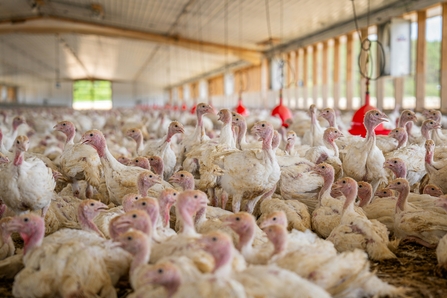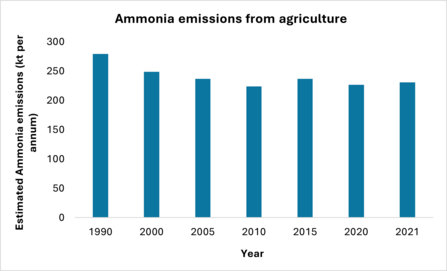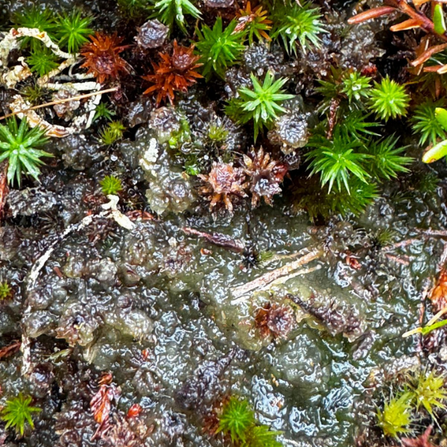Atmospheric pollutants are diverse in nature: they may be particulate (such as dust deposits), or they may be chemical (such as gaseous vehicle emissions). These pollutants may be relatively localised or carried some distance in the atmosphere before deposition occurs during rainfall events. Peatlands are particularly vulnerable to atmospheric pollution as they receive high levels of precipitation (rain, sleet, snow or hail) and occult precipitation (fog, dew, mist or cloud water).
All the UK’s peatlands are sensitive to nutrient inputs, but particularly naturally nutrient poor, acidic peat bogs. Atmospheric sulphur deposition, which began during the industrial revolution and peaked in the 1970s, has broadly declined below critical load and is thought to no longer be suppressing most peatland species. Nitrogen oxide levels from vehicle emissions have also fallen by over 66% from their 1990 highs. The legacy of these historic pollutants was acid rain which led to extensive loss of vegetation and bare peat exposure. These effects are particularly acute in areas such as the Peak District, making restoration particularly challenging. Instances of wildfire have also led to the release of some of these chemicals back into the atmosphere.

Intensive livestock agriculture, particularly pigs and poultry, is the major source of ammonia in the UK. Credit Mark Stebnicki
Nitrogenous compounds such as ammonia, which are predominantly a product of intensive farming (which produces ~88% of ammonia emissions1), are on a generally decreasing trend but remain significant.

Ammonia emissions have generally been falling from agriculture but have seen recent rises due to increases in the number of intensive poultry and pig farms. Source: Defra2.
These pollutants are deposited onto peatlands in a number of ways (as both gases and particulates). They may be deposited in rain, blown and deposited by air or in ephemeral, occult precipitation such as cloud droplets. The impact of deposition increases with altitude, with increased ionic concentrations and snow melt also concentrating deposition into single events3. Upland peatlands with their increased altitude are therefore more likely to be vulnerable to atmospheric deposition, even in remote areas.
Blanket bogs and raised bogs are acidic by nature and thus the species which grow in them are tolerant of these conditions. However, nitrogen and sulphur deposition cause an unnatural increase in acidity, which alters this balance. Sulphur compounds are also toxic to key peat-forming Sphagnum mosses. Increased acidity may also cause the leaching of base cations such as potassium across cell membranes, which mosses are particularly vulnerable to3. Additionally, this increased nutrient load has been found to favour increased algal and grass growth on bogs, and where this growth is prolific it may smother mosses.

Algal growth on blanket bog in Ffynnon Eidda on Migneint, Wales, taken in 2024. Credit: Dave Reed.
Despite reductions, the overall picture is that nitrogen and acidic depositions from the atmosphere are still exceeding critical loads for blanket peatlands across approximately half of the UK. With 80% of UK peatlands in a degraded condition, they will also likely exhibit increased sensitivity to these high loads.
Atmospheric pollutants are also deposited in the form of particulates, some of which contain heavy metal compounds. It is likely that there are adverse effects of deposition of these atmospheric pollutants over a significantly greater area than the critical loads for healthy bog suggest. Falling sulphur levels which are generally regarded now as being below critical loads have allowed the slow recovery of Sphagnum in areas such as the South Pennines, where it was steadily lost from the industrial revolution onwards. Ensuring that ammonia and nitrate levels continue a downward trajectory will be key in ensuring future peatland health.
References
1. Studio Republic. Nitrogen related pollution contributes to poor air and water quality - CIWEM [Internet]. CIWEM. 2015. Available from: https://www.ciwem.org/news/blog-nitrogen-related-pollution-is-bad-news-all-round accessed 9/5/2025
2. Inventory of Ammonia Emissions from UK Agriculture 2021 Defra Contract SCF0107 [Internet]. Available from: https://uk-air.defra.gov.uk/reports/cat09/2307061001_UK_Agriculture_Ammonia_Emission_Report_1990-2021_Final.pdf accessed 9/5/2025
3. Acid deposition :: Montane habitats | Air Pollution Information System [Internet]. Apis.ac.uk. 2016. Available from: Acid deposition :: Montane habitats | APIS accessed 23/7/2025

